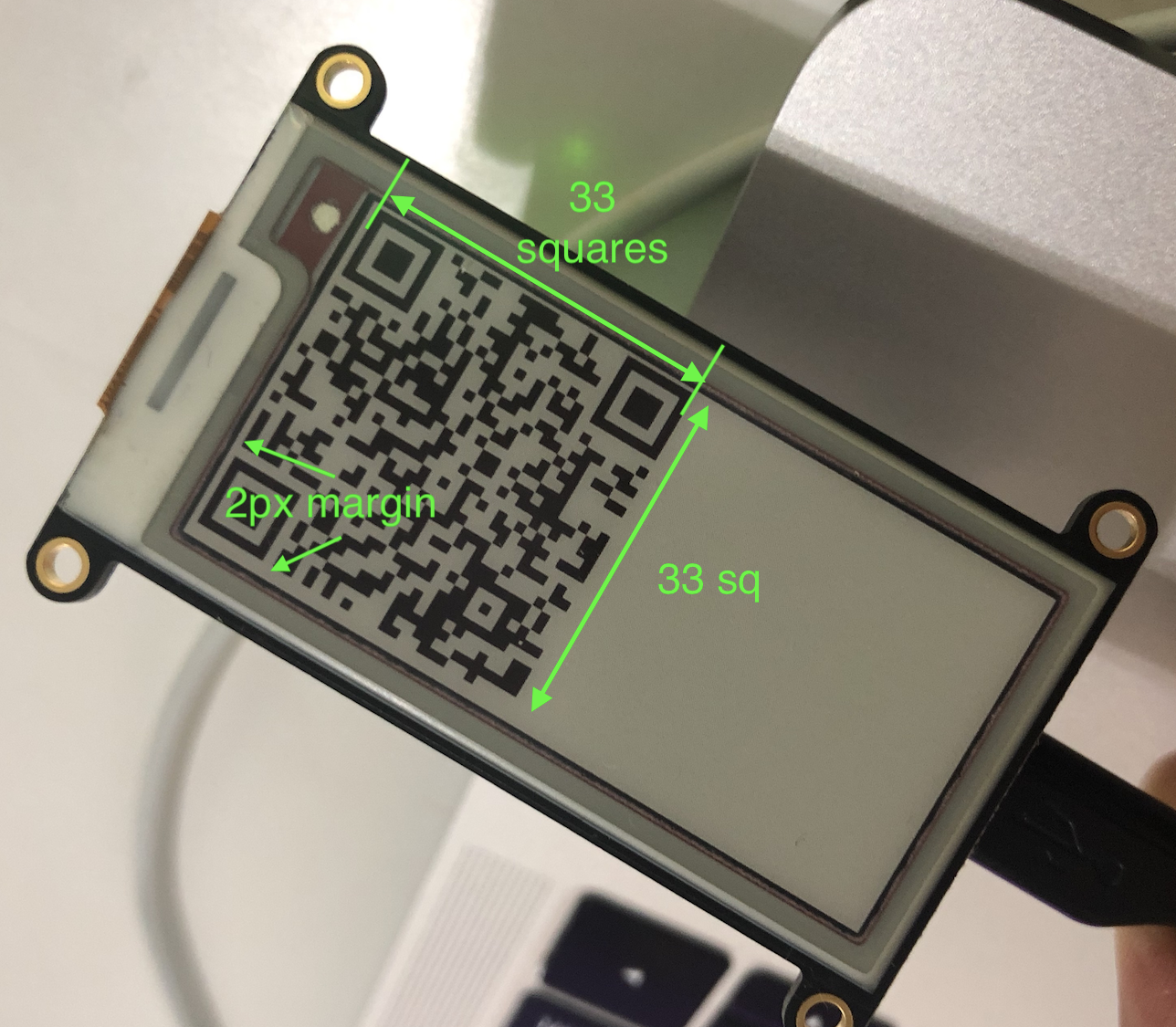QRCode on Arduino
For the e-Paper project I worked before I had to generate a QR code. The QR code encodes the login URL. The idea is that you point a phone’s camera to it. Modern phones are configured to scan QRCodes automagically with their cameras and prompt the user to open a URL (the login URL in my case). Pretty convenient.
I knew very little about QR codes before this project, so I started studying a little bit about it (a.k.a. googling), and more explicitly, learning more about how to generate them on an Arduino board.
Attempt 1 - Server Side code generation
Very easily, I found a few libraries for node, my de facto platform to experiment. This handler with express creates a QR code with whatever you send on a data query parameter:
const qrc = require('qrcode');
server.get('/', (req, res, next) => {
if(!req.query.data){
return next(boom.badRequest(err));
}
qrc.toDataURL(req.query.data, (err, url) => {
return res.render('../apps/qrcode/views/qrcode', {dataUrl: url});
});
});
The view:
<!DOCTYPE html/>
<html>
<head>
<title>qrcode</title>
</head>
<body>
<img src='<%=dataUrl%>'/>
</body>
</html>
This generates an small HTML page with an embedded/encoded image:
<!DOCTYPE html/>
<html>
<head>
<title>qrcode</title>
</head>
<body>
<img src='data:image/png;base64,iVBORw0KGgoAAAANSUhEUgAAAHQAAAB0CAYAAABUmhYnAAAAAklEQVR4AewaftIAAAK6SURBVO3BQQ7bWAwFwX6E7n/lHi+5+oAg2ckwrIofrDGKNUqxRinWKMUapVijFGuUYo1SrFGKNUqxRinWKMUapVijFGuUYo1y8VASfknliSScqHRJ+CWVJ4o1SrFGKdYoFy9TeVMS7khCp3KicofKm5LwpmKNUqxRijXKxZcl4Q6VO5Jwh0qXhE7ljiTcofJNxRqlWKMUa5SLYVT+ZcUapVijFGuUYo1SrFGKNUqxRrn4MpVfSkKn0iWhU3lC5W9SrFGKNUqxRrl4WRL+JJUuCZ1Kl4RO5SQJf7NijVKsUYo1SvzgfywJd6hMVqxRijVKsUaJHzyQhE6lS8KbVO5IwonKSRLepPJNxRqlWKMUa5T4wQNJeELljiR0Knck4QmVkyR0KidJ6FSeKNYoxRqlWKNc/GFJ6FS6JHQqXRLuUOmS0Kl0SeiS0KnckYRO5U3FGqVYoxRrlPjBi5LQqbwpCX+SykkSTlS6JHQqTxRrlGKNUqxRLh5KQqfSJeFEpUvCicpJEjqVkyR0KidJ6FQ6lZMkdCpvKtYoxRqlWKNcPKRyonKHyh1J6FS6JHQq35SETqVT6ZLQqTxRrFGKNUqxRokfPJCEX1J5IgmdSpeETuUkCScqXRI6lTcVa5RijVKsUS5epvKmJJwk4USlUzlROUnCiUqXhJMkdCpPFGuUYo1SrFEuviwJd6h8UxI6lS4JnUqn0iXhDpVvKtYoxRqlWKNcDKNyRxJOktCpdCpdEjqVXyrWKMUapVijXPxjVLokdCpdErokdCqdyp9UrFGKNUqxRrn4MpVvUumS8EQSTlROktCp/FKxRinWKMUa5eJlSfilJNyh0iWhUzlJQqfSqXRJOFF5U7FGKdYoxRolfrDGKNYoxRqlWKMUa5RijVKsUYo1SrFGKdYoxRqlWKMUa5RijVKsUYo1yn80PiTPpw0hKQAAAABJRU5ErkJggg=='/>
</body>
</html>
My first thought was to do precisely this:
- Have the Arduino board send a request to an endpoint (using the login URL as the parameter).
- Download the bitmap.
- Send the bitmap to the display.
I assumed that the display would be able to deal with bitmaps quite easily, and I have the components I needed: an HTTP request/response module, code for the QR code, among others.
However, I wasn’t super happy with having another network call for this.
Attempt 2 - Stand alone solution
Searching a little bit more, I found this other C library designed explicitly for small footprint devices.
I have not tested its claims on performance, memory, but it works! Also, it is straightforward to use.
Basic usage
QRCode qrcode;
uint8_t qrcodeData[qrcode_getBufferSize(QRCODE_VERSION)];
qrcode_initText(&qrcode, qrcodeData, QRCODE_VERSION, ECC_LOW, "Some content");
int cell = qrcode_getModule(&qrcode, x, y);
How it works?
- Allocate a buffer (based on the
versionof QRCode you want). - Call
qrcode_initTextto generate it. - The code is essentially a matrix of black/white squares. You can inspect each cell of the matrix with
qrcode_getModule.
Drawing it on a display (or a printer) is up to the implementer, which is what comes next.
Choosing the right QRCode version
What’s left is printing the matrix on a display. You need to draw black or white for each cell of the matrix using the qrcode_getModule.
The size of the matrix is dependent on two parameters:
- The amount of information to store.
- The error correction algorithm (which creates redundancy).
In my application, I need to encode a URL of the form:
https://{auth0 hosted domain}/activate?user_code=1234-ABCD
Auth0 supports custom domains, which means it can be anything, Typically, it takes the form of something like https://login.myapp.com. If you don’t use Custom Domains then the login URL is a subdomain of auth0.com: https://example.auth0.com.
The full URL will something between 50 and 70 characters and because the integrity if the QRcode is high on this display, we need Low error correction. (LOW_ECC constant). Based on this chart, the smallest we can go to is a 29x29 QRcode. The 33x33 QRCode in LOW_ECC can encode a 114 alphanumeric string, which gives us some leeway, so I decided to use that.
Drawing the QRCode
The QRCode is square, so the constraint on painting it on any display is on the smallest dimension. The e-paper display I am using is 104 x 204 pixels (height x width), so the constraint is on the height (104 pixels). I wanted to maximize the size, so taking a couple pixels from the borders to add some space for margins I ended up with:
QRCode square size = Round(( 104 - 2x2 ) / 33) = 3
This means I can draw a single QR code module as a 3x3 pixels square on the display.
In code:
void PrintQRCode(const char * url){
QRCode qrcode;
const int ps = 3; //pixels / square
uint8_t qrcodeData[qrcode_getBufferSize(QRCODE_VERSION)];
qrcode_initText(&qrcode, qrcodeData, QRCODE_VERSION, ECC_LOW, url);
epd.clearDisplay();
for (uint8_t y = 0; y < qrcode.size; y++) {
for (uint8_t x = 0; x < qrcode.size; x++) {
//If pixel is on, we draw a ps x ps black square
if(qrcode_getModule(&qrcode, x, y)){
for(int xi = x*ps + 2; xi < x*ps + ps + 2; xi++){
for(int yi= y*ps + 2; yi < y*ps + ps + 2; yi++){
epd.writePixel(xi, yi, EPD_BLACK);
}
}
}
}
}
}
The end result is a neat QRCode:
